Physical Address
304 North Cardinal St.
Dorchester Center, MA 02124
Physical Address
304 North Cardinal St.
Dorchester Center, MA 02124
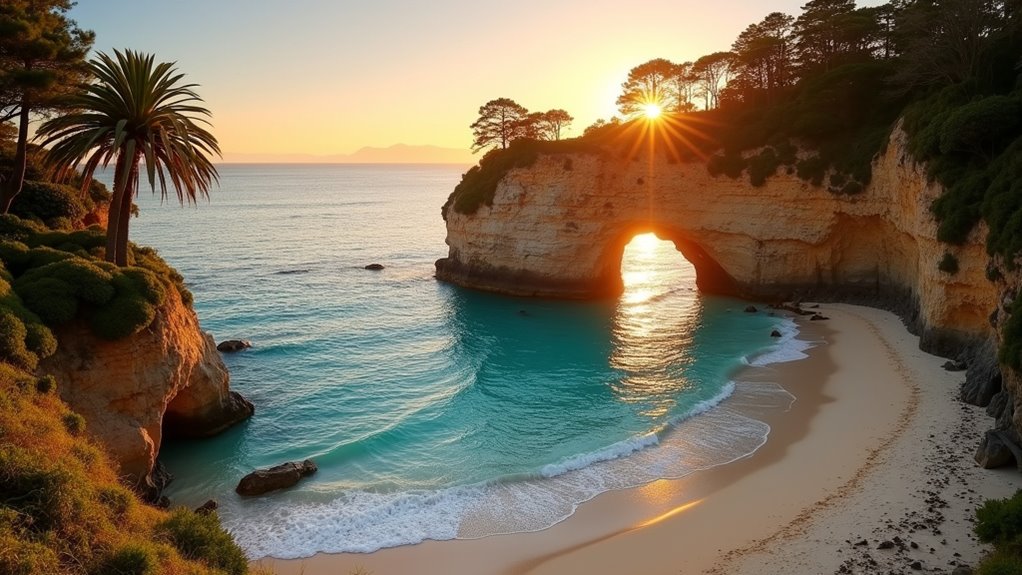
Kiwi sun-seekers rejoice in these 9 golden havens where warmth abounds and adventure calls—but which spot claims the sunshine crown?
New Zealand’s sunniest spots include Nelson (the sunshine capital), Blenheim with its wine-friendly climate, and Napier’s Art Deco charm. You’ll find subtropical warmth in Kaitaia and Whangarei in the Far North. Don’t miss Gisborne (first to see the sun), Whakatane (North Island’s sunniest spot), and the coastal paradises of Tauranga and Hastings. These regions offer perfect conditions for beaches, hikes, and outdoor adventures throughout the year. Discover which warm haven suits your sun-seeking style below.
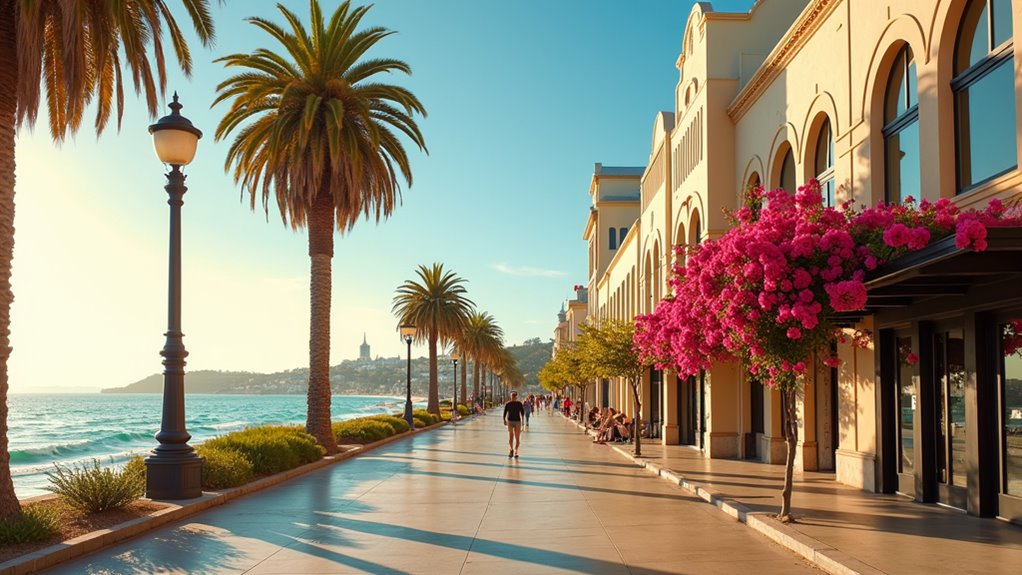
Situated on New Zealand’s North Island, Napier enjoys a temperate maritime climate that makes it one of the country’s warmest destinations. With approximately 2,255 sunshine hours annually, you’ll find plenty of bright days to explore its famous Art Deco architecture.
Napier’s sun-drenched climate offers the perfect backdrop for discovering its stunning Art Deco treasures.
Summer temperatures reach a comfortable 76°F, while winters remain mild at around 44°F. December offers nearly 8 hours of daily sunshine, making it perfect for vineyard tours and beach visits. The warm season lasts about 3.3 months from early December to mid-March with consistently pleasant temperatures.
Even in winter, you’ll still enjoy about 4.4 hours of sunshine daily.
The annual rainfall of 864mm is moderate, with July being the wettest month. This favorable climate supports Napier’s vibrant cultural scene and picturesque landscapes year-round, giving you reliable weather for outdoor activities regardless of when you visit. Napier is considered one of New Zealand’s attractions that combines natural beauty with unique architectural heritage.
While Napier boasts impressive sunshine, Nelson claims the crown as New Zealand’s true sunshine capital. With up to 2,676 annual sunshine hours, this northern South Island gem outshines even Melbourne, Australia.
You’ll enjoy the sunniest days in January (up to 268 hours) while June offers a respectable 145 hours of winter sunshine. February and March continue the summer brightness with 238.8 hours and 230.8 hours respectively. This favorable climate creates perfect conditions for exploring Abel Tasman National Park‘s stunning beaches or hiking through Nelson Lakes’ scenic landscapes.
The abundant sunshine powers Nelson’s thriving wine production and agricultural sector while fueling a vibrant cultural scene. Unlike the debate between Australian coasts, New Zealand’s sunshine choice is clear with Nelson at the top. Whether you’re visiting the numerous galleries, relaxing in Queen’s Gardens, or enjoying water sports in Tasman Bay, you’ll appreciate why residents and travelers alike are drawn to New Zealand’s sunniest region.

Located just 30 minutes from Nelson, Blenheim stands as one of New Zealand’s warmest and sunniest destinations with an impressive climate that makes it perfect for wine production.
Marlborough’s crown jewel offers ideal sunshine and warmth for world-class wine cultivation
You’ll enjoy temperatures ranging from 41°F to 73°F throughout the year, with a comfortable annual mean of 53.7°F. Despite consistent rainfall spread across all months, Blenheim remains one of the country’s sunniest spots.
February and March offer the warmest conditions for exploring the region’s renowned vineyards and wineries. The area’s wine tourism scene thrives on its favorable climate, with numerous tasting opportunities and outdoor activities available year-round. While exploring the surrounding landscapes, you might catch glimpses of native wildlife that make New Zealand’s ecosystem so unique. Visitors can experience the clearest skies during March when 64% clear days create ideal conditions for outdoor wine tastings.
When visiting, you’ll appreciate the well-developed tourism infrastructure and the welcoming local community that’s built around showcasing Marlborough’s exceptional wines.
The Bay of Plenty earns its name through Tauranga and Mount Maunganui, two coastal gems offering some of New Zealand’s most pleasant year-round temperatures. With daytime highs reaching 23°C in summer and rarely dipping below 15°C in winter, you’ll enjoy comfortable conditions whenever you visit.
January delivers peak sunshine with an impressive 8.7 daily hours of golden rays, perfect for enjoying the region’s stunning beaches and coastal scenery. The region experiences a warm temperate climate classified as Cfb according to the Köppen-Geiger system. Though rainfall is consistent throughout the year (about 1379mm annually), it’s balanced by ample sunshine.
You’ll find plenty to do here – climb Mount Maunganui for breathtaking views, try your hand at surfing, or sample local seafood and wines. The moderate climate supports year-round outdoor activities, making this area a true paradise for sun seekers. Unlike many tropical paradises, you can explore without concerns about encountering wild snakes as New Zealand is one of the few countries with no native snakes in its ecosystem.
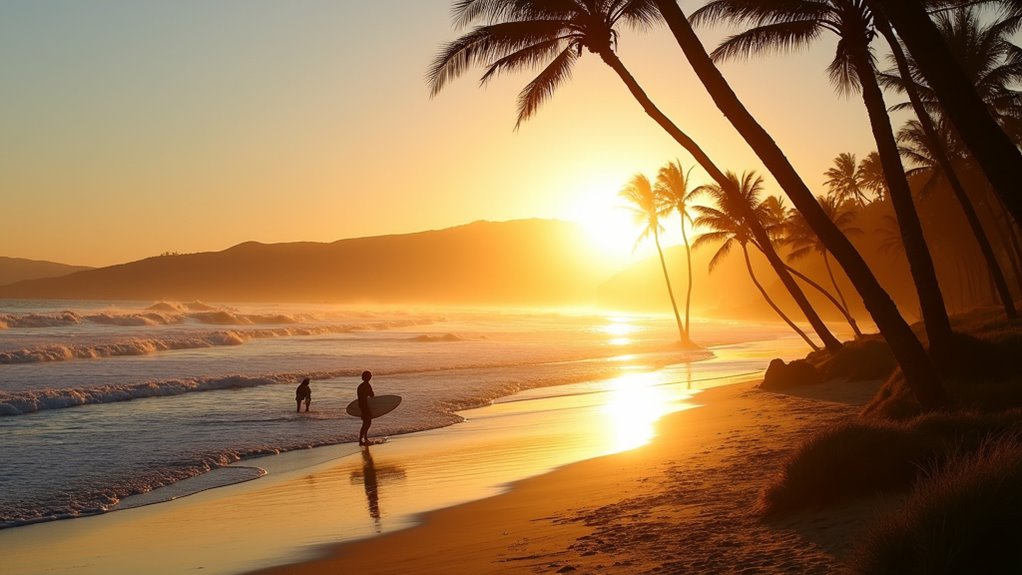
As the first city in the world to greet each new day, Gisborne offers you a truly unique experience on New Zealand’s North Island. Located in the Tairāwhiti region—meaning “the coast upon which the sun shines across the water”—this sunny destination enjoys a temperate climate with mild winters and warm summers.
You’ll find temperatures typically ranging from 18°C to 26°C in summer, with high sunshine hours year-round. This geographical distinction stems from decisions made at the International Meridian Conference of 1884.
The golden beaches, including Anaura Bay, provide perfect spots for sunrise walks and photography. Don’t miss Mount Hikurangi, where Māori cultural tours combine natural beauty with traditional significance.
The region’s wine producers even capitalize on Gisborne’s sunny reputation with sunrise breakfasts and tastings, making it an ideal destination for sun-seeking travelers. While exploring the North Island, consider adding thermal wonders to your itinerary in nearby Rotorua, a must-visit destination for nature enthusiasts.
While Gisborne catches the first rays of the New Zealand sun, Whakatane proudly claims the title of sunshine capital on the North Island’s east coast. You’ll enjoy a mild climate year-round with average temperatures of 14.2°C, peaking at 24°C during February.
In January, you can bask in up to 8.3 hours of daily sunshine, making it ideal for beach activities and outdoor adventures. Despite receiving about 1426mm of annual rainfall (mostly in June), the consistent sunshine hours more than compensate. The region experiences its wettest season from May to October, with July seeing the highest monthly rainfall at approximately 3.9 inches.
When you visit, you’ll appreciate the accessibility to stunning beaches, hiking trails, and water sports. Beyond human visitors, the region is part of a country with unique wildlife that evolved in isolation for millions of years. For the warmest experience, plan your trip during summer months when temperatures are highest and rainfall is lowest.
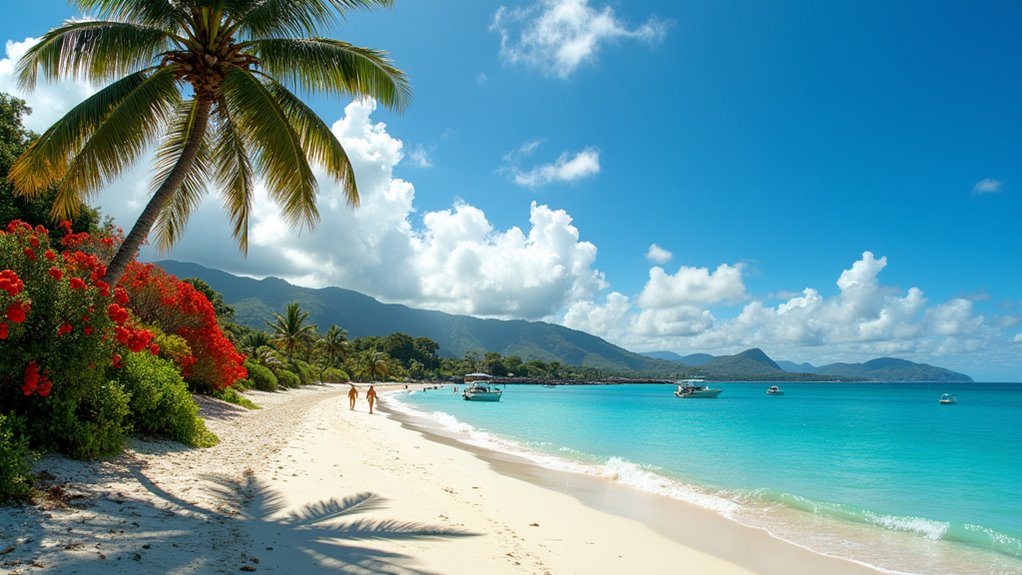
Heading north to Kaitaia, you’ll discover one of New Zealand’s most authentically subtropical environments. This northern gateway town enjoys temperatures ranging from 12°C to 23°C year-round, with a humid climate that supports more tropical flora than you’ll find elsewhere in the country.
Kaitaia’s climate advantages include:
As a base for exploring Ninety Mile Beach and Cape Reinga, Kaitaia’s warm climate has fostered thriving avocado orchards, Mānuka honey production, and emerging vineyards—all demonstration to its subtropical character. The region’s warmth has allowed aspects of Māori culture to flourish, with traditional practices closely connected to the natural environment. Mean daily maximum temperatures can reach as high as 28.3°C during summer months, offering a truly warm escape.
Nestled in the heart of Hawke’s Bay, Hastings boasts a Mediterranean-style climate that makes it one of New Zealand’s warmest and sunniest destinations. You’ll enjoy about 2,200 sunshine hours annually with summer temperatures in the mid-20s°C and mild winters averaging 14.5°C.
With just 126 rainy days yearly, the climate perfectly supports both tourism and agriculture. The warm season lasts for 3.3 months from December to March with temperatures above 71°F. You can explore over 350km of coastline, hike Te Mata Peak, or tour local wineries in the reliable sunshine.
This climate has made Hastings New Zealand’s largest producer of pip and stone fruit and second-largest wine grape region. Rainfall distributes evenly throughout the year, with drier summers (December-February) and slightly wetter winters (June-August), creating ideal conditions for outdoor activities year-round. Hastings is also known as one of the affordable places to live in New Zealand while still enjoying premium weather conditions.
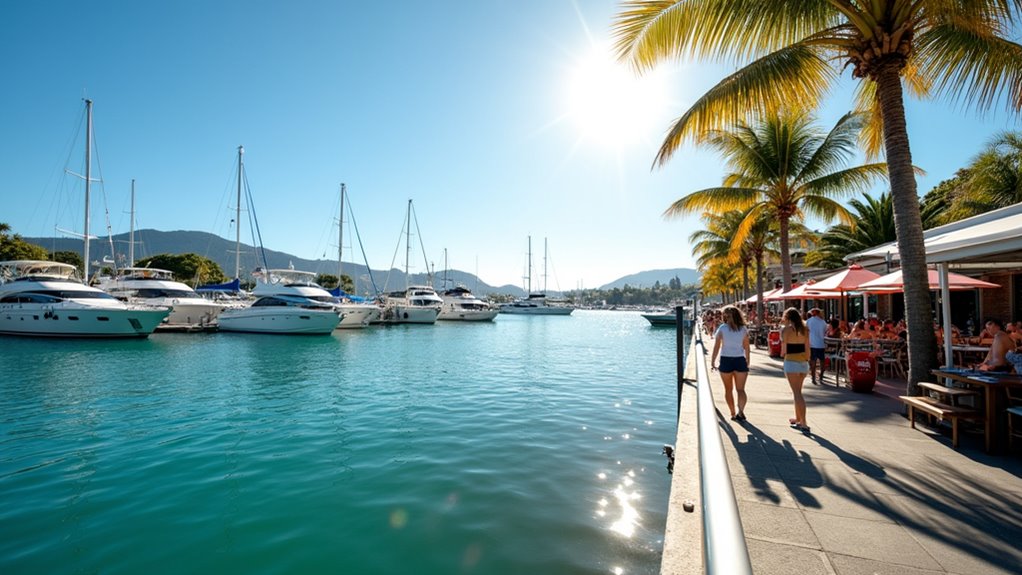
Located in New Zealand’s northernmost region, Whangarei offers visitors a subtropical maritime climate that ranks among the country’s warmest destinations. With average annual temperatures around 15°C (59°F) and summer highs regularly exceeding 22°C (72°F), you’ll enjoy a consistently comfortable climate year-round.
When planning your visit, keep these advantages in mind:
February stands out as the hottest month with average highs of 75°F and pleasantly warm water temperatures perfect for swimming.
The region’s subtropical conditions create an ideal environment for outdoor adventures along the coast and harbor areas. Despite the comfortable climate, visitors should be aware that New Zealand has a cost of living that varies significantly between urban and rural areas.
Whether you’re planning a permanent move or a sun-soaked vacation, New Zealand offers plenty of warm-weather havens. Nelson boasts an impressive 2,500+ hours of sunshine annually, making it the country’s sunniest region by far. You’ll find mild winters and balmy summers across these nine destinations, with temperatures regularly climbing above 20°C during summer months. Pack your sunscreen and make the most of these radiant Kiwi hotspots.